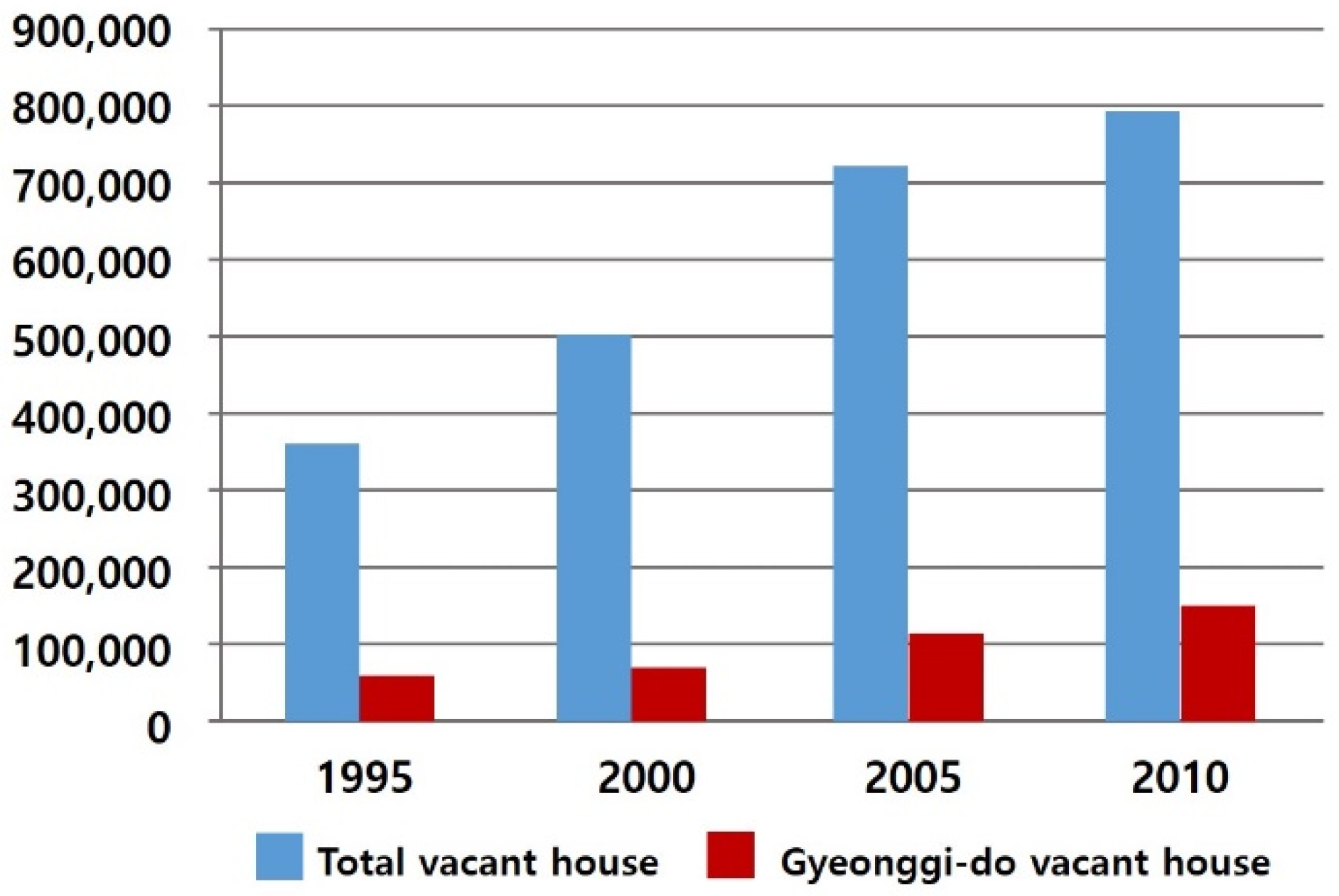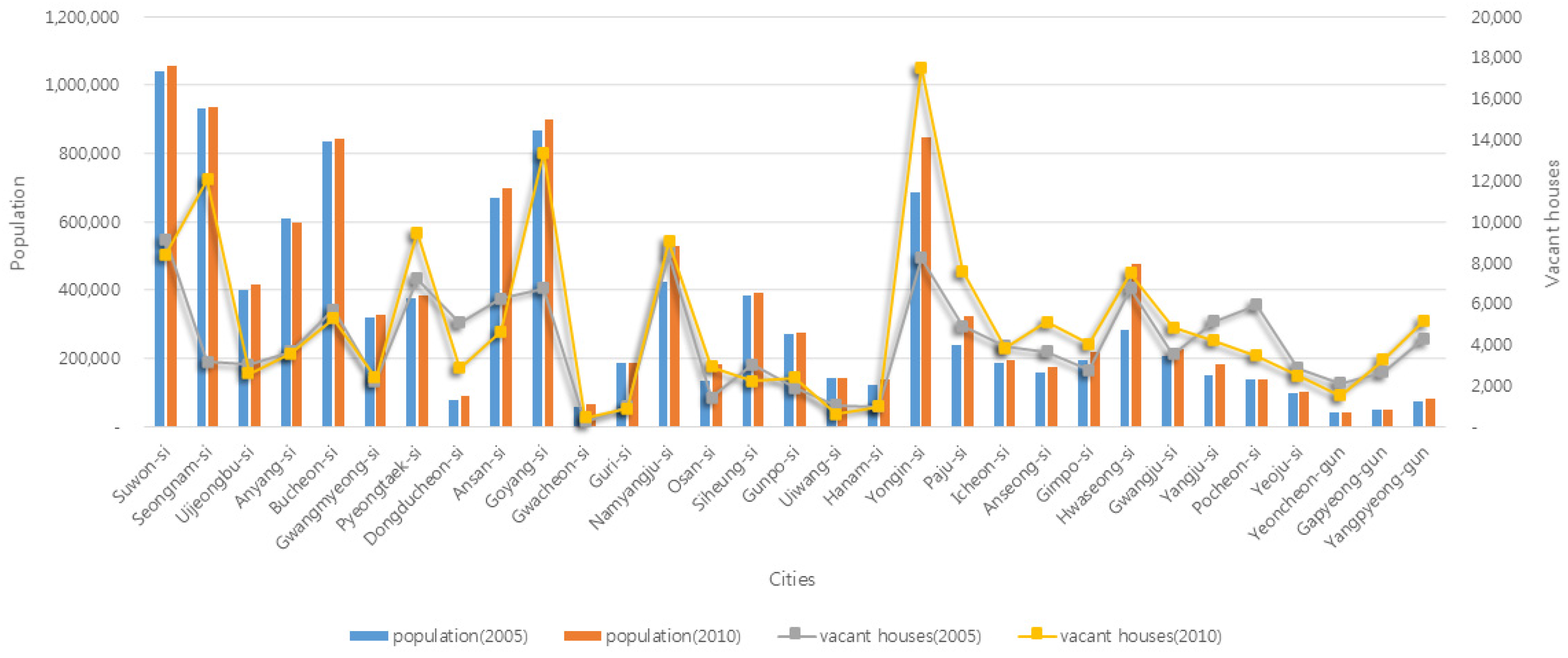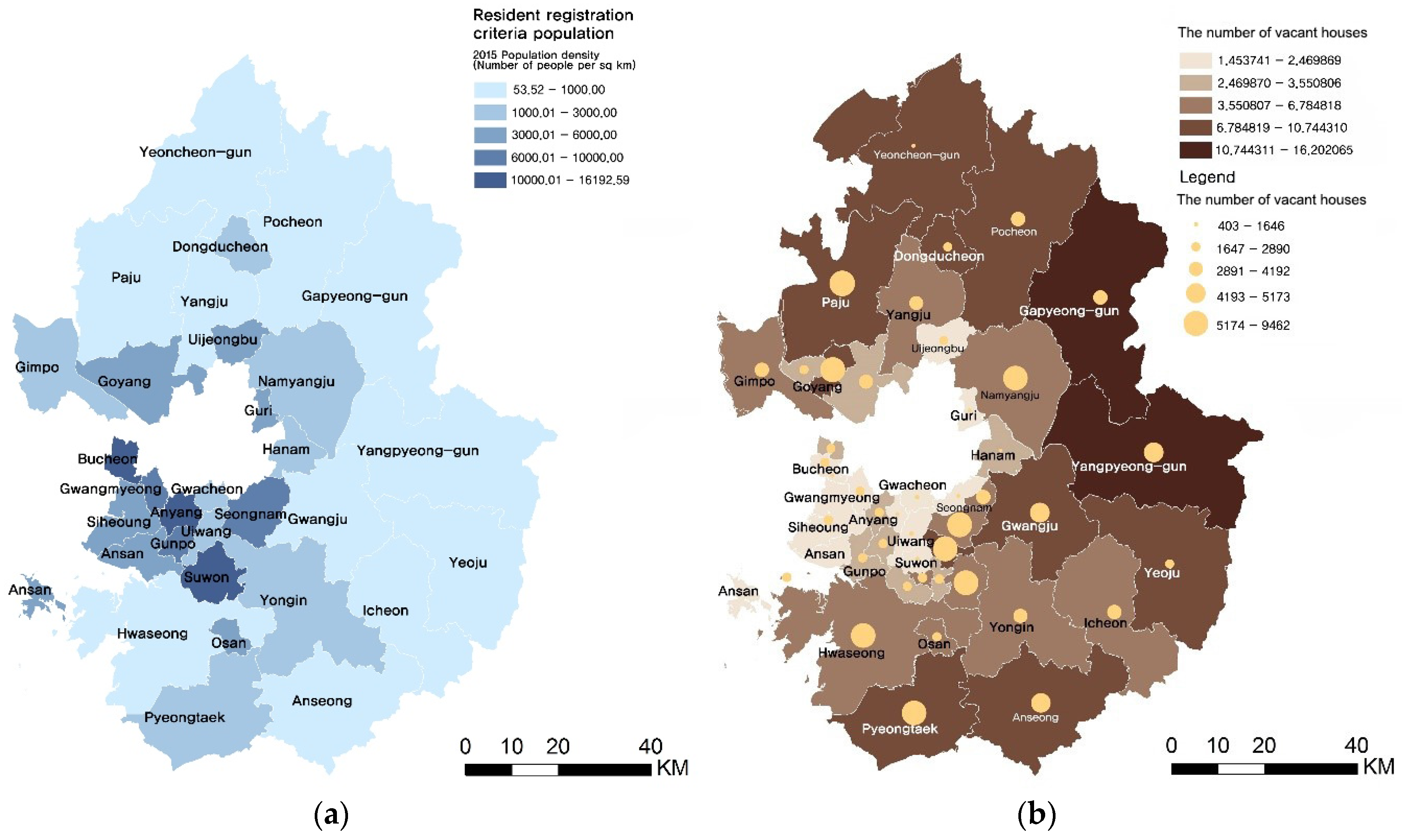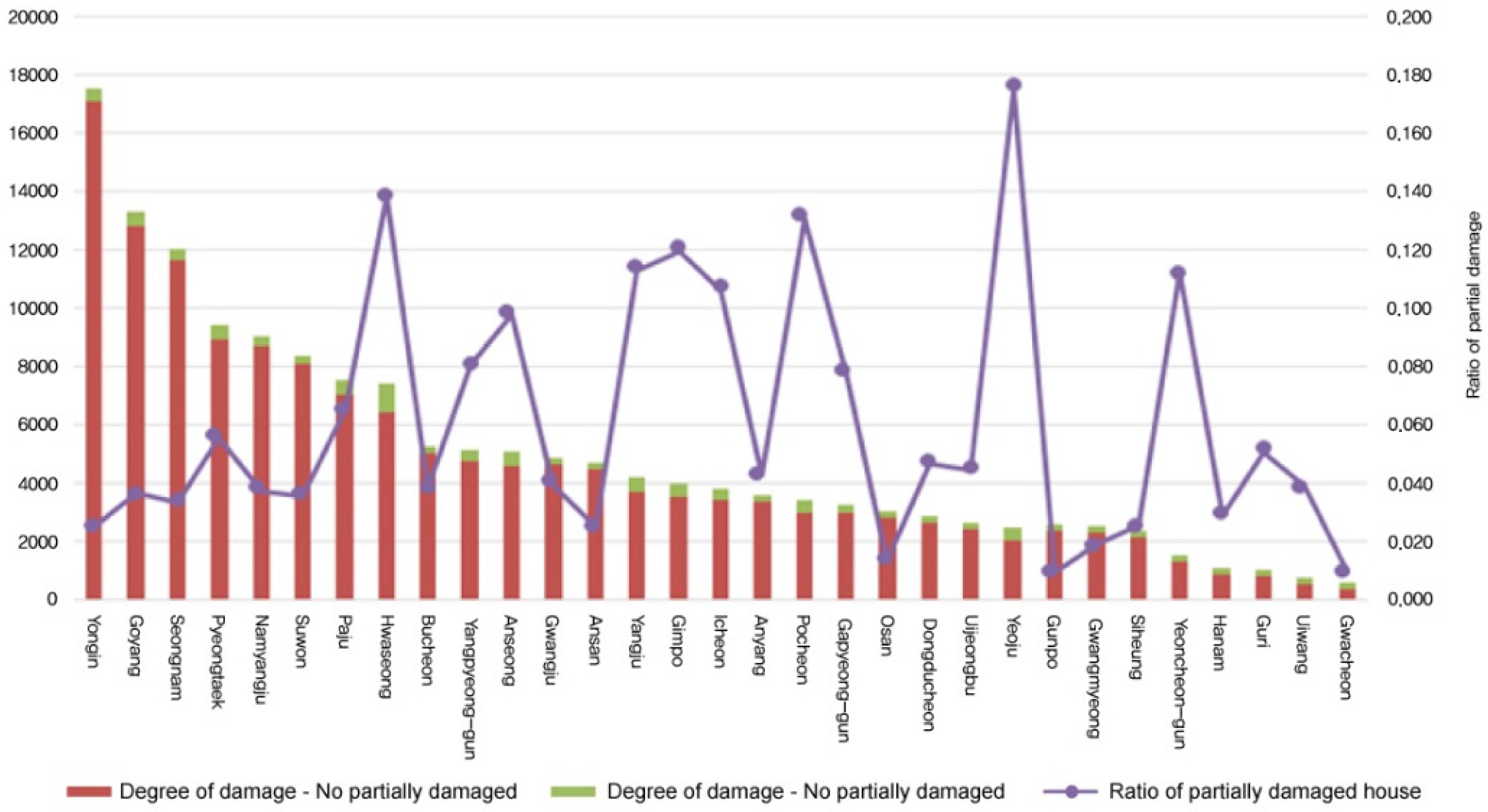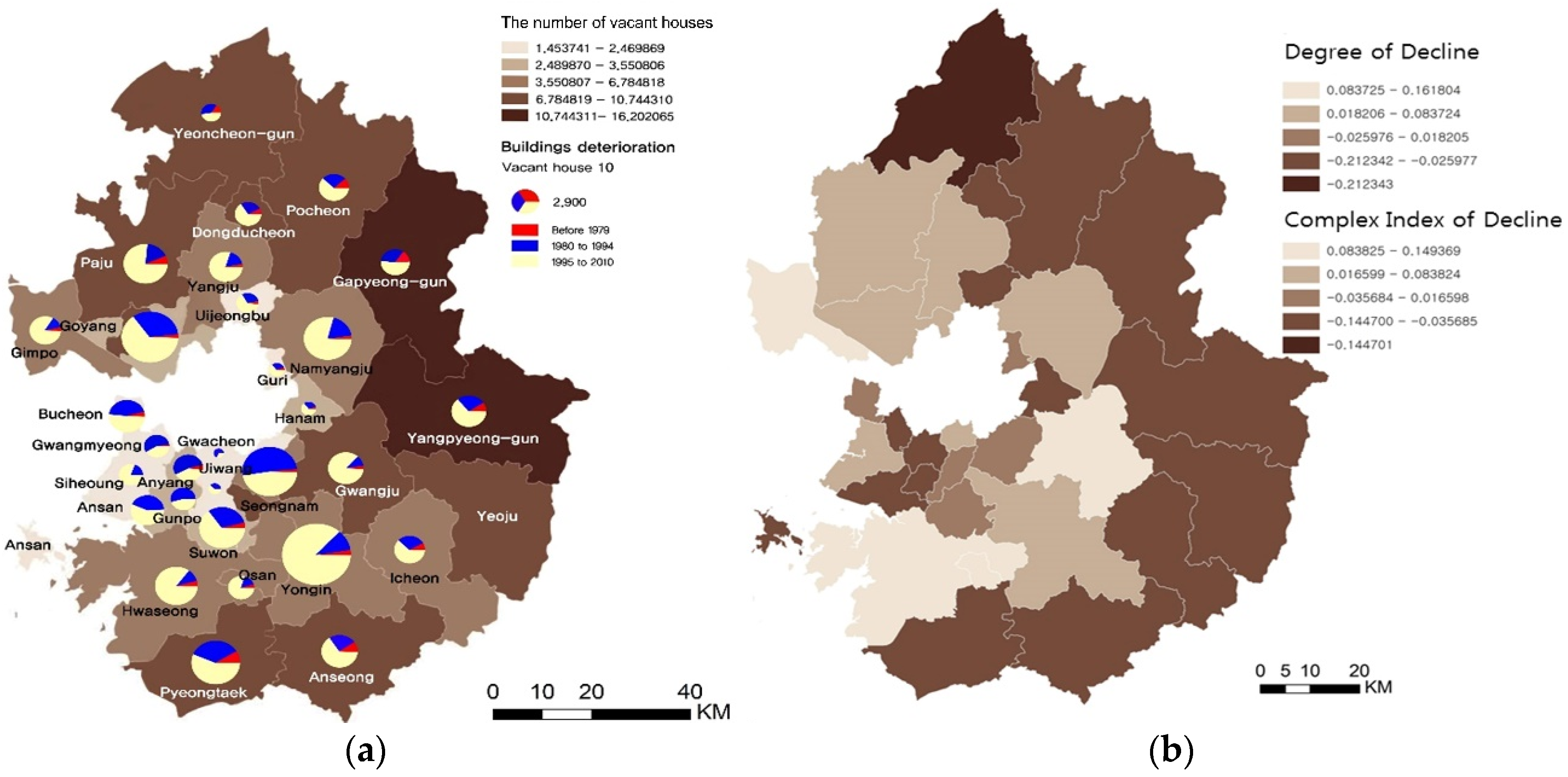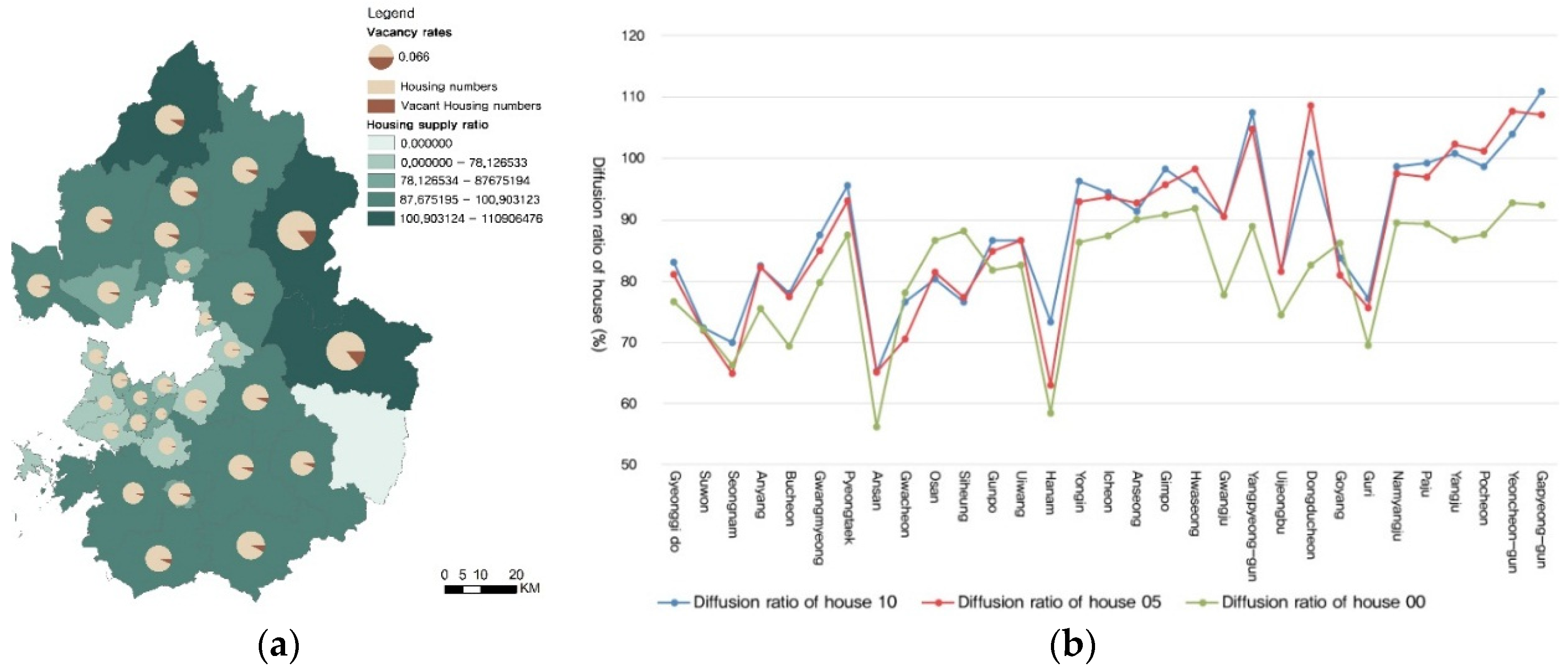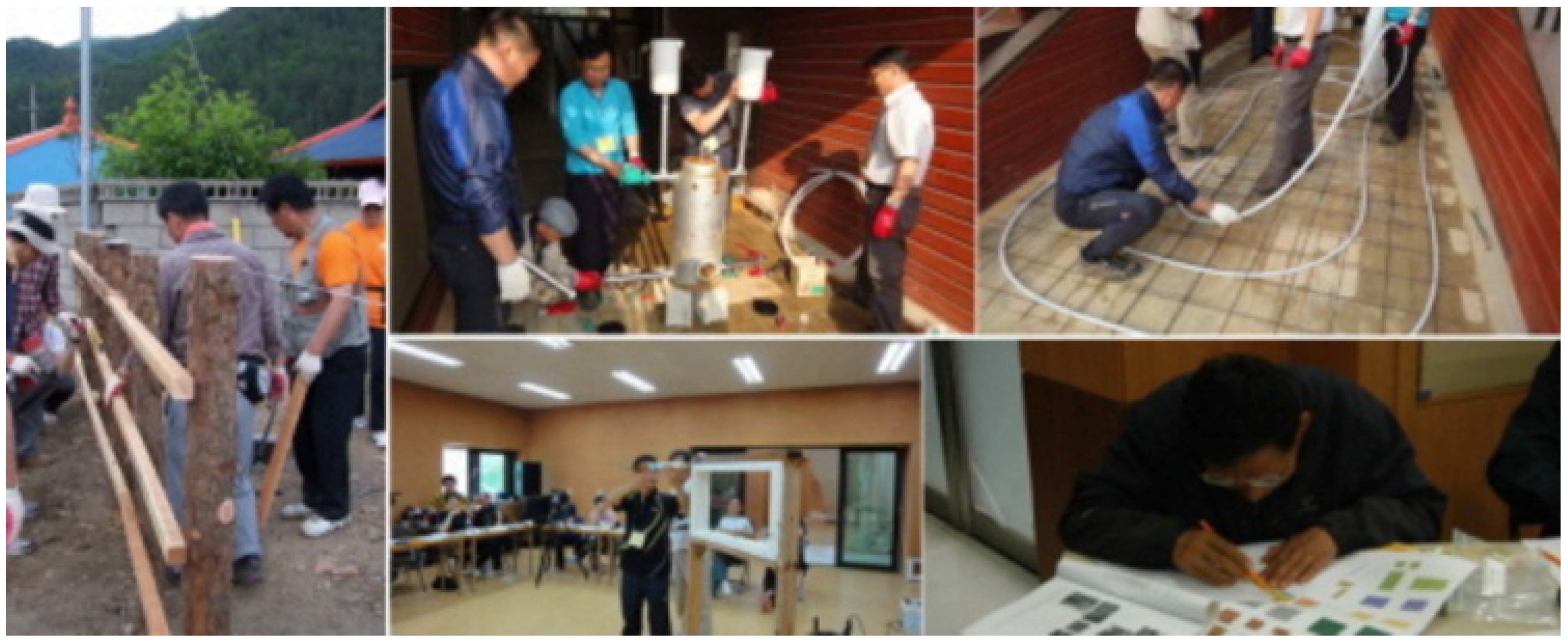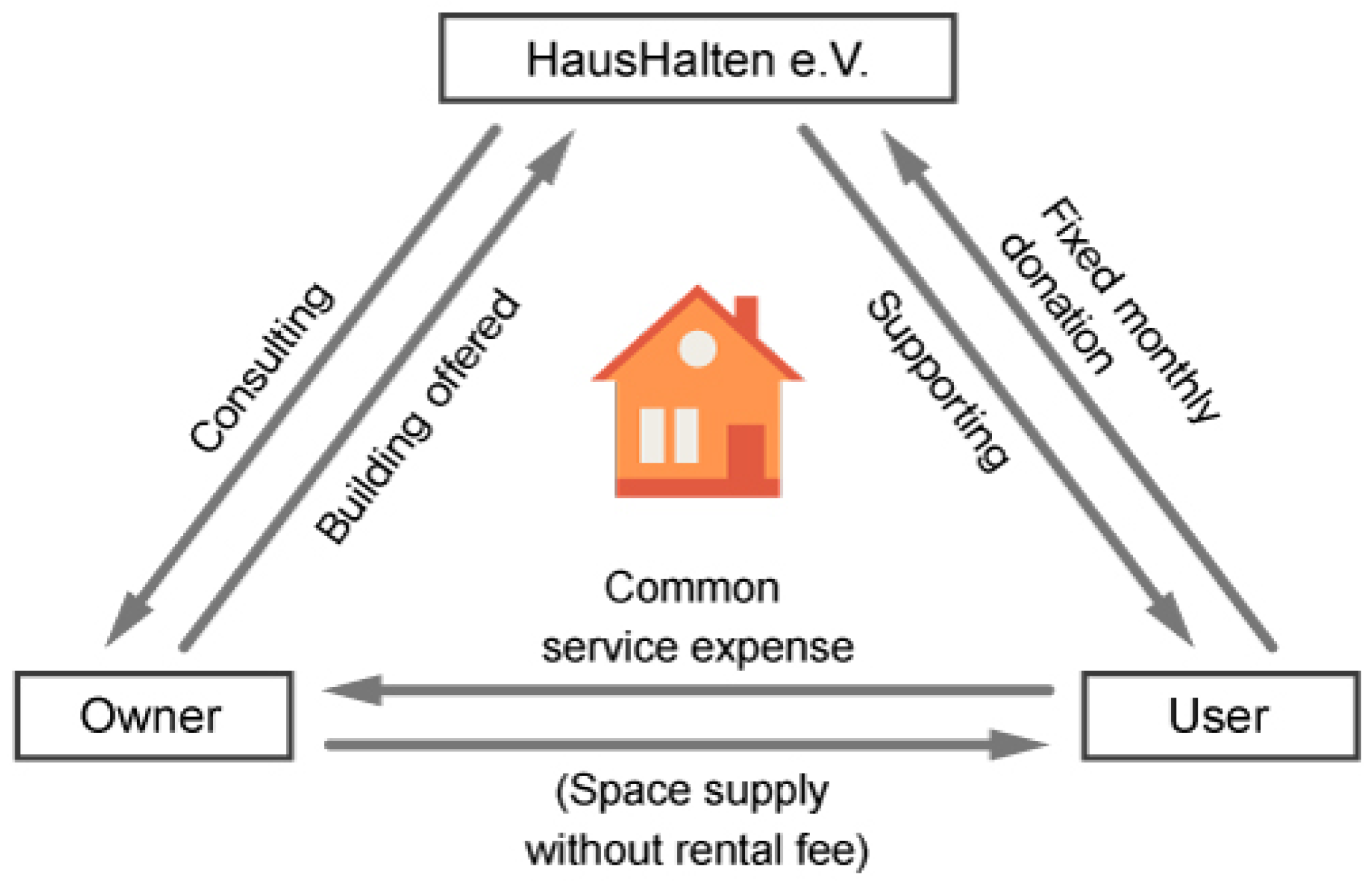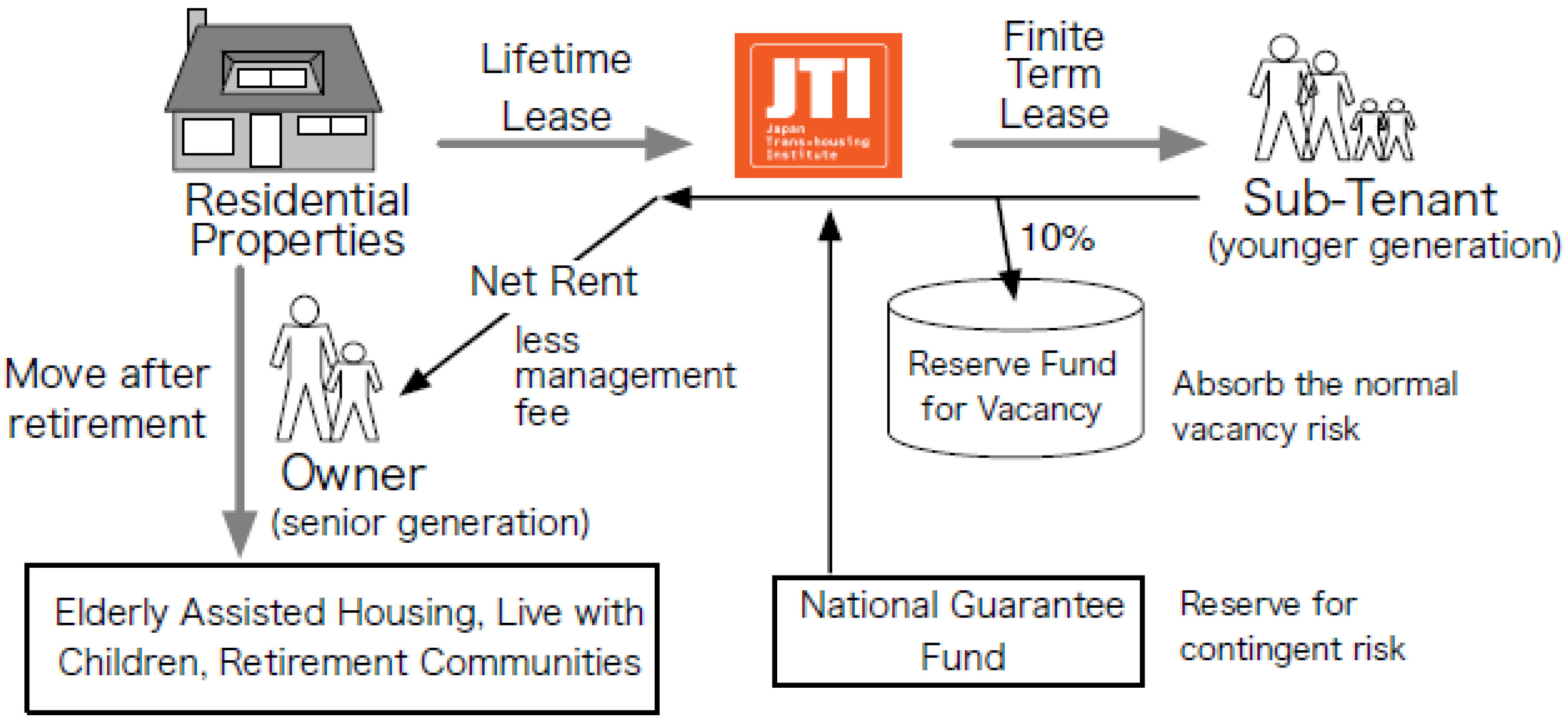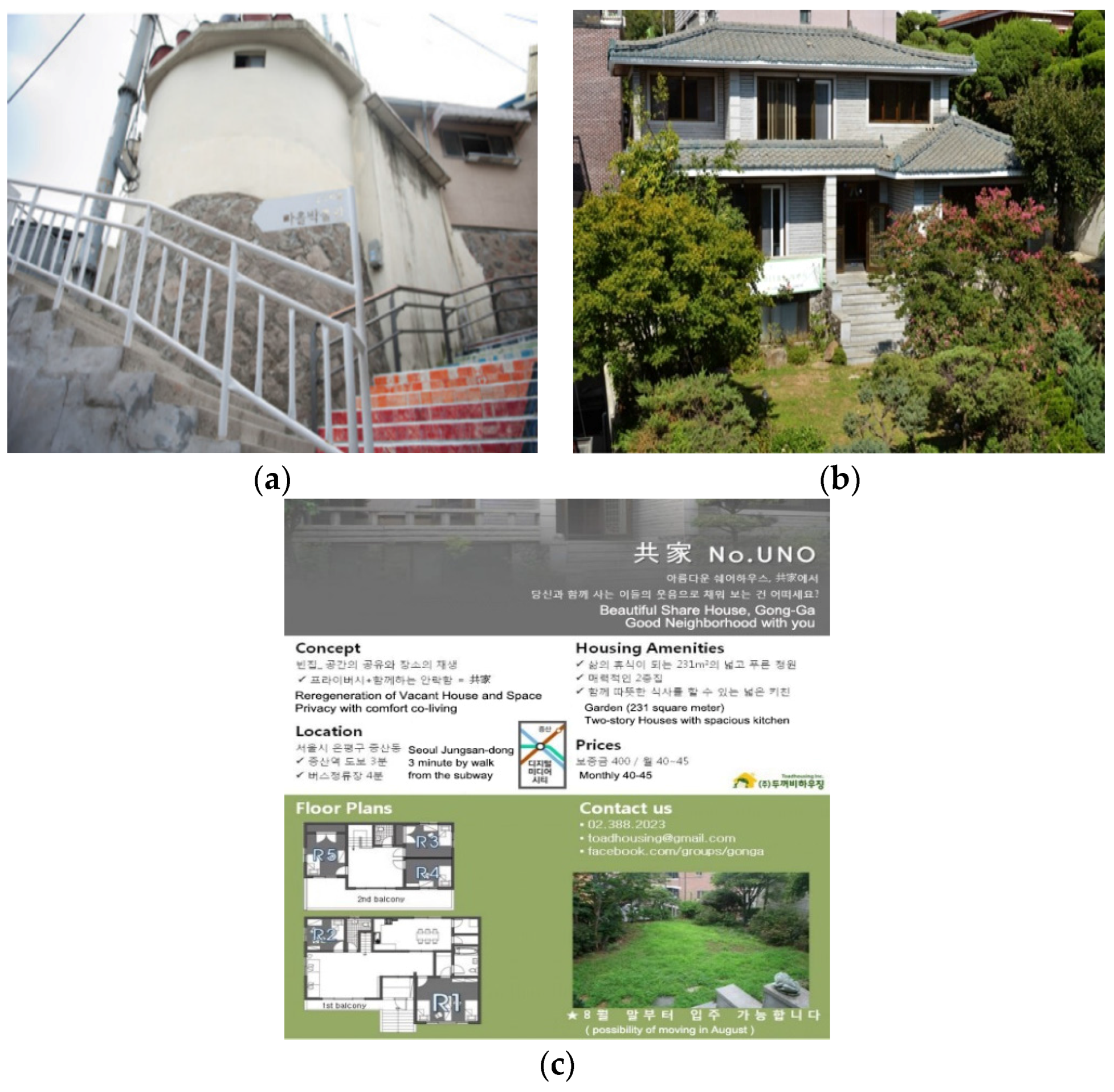4.1. Population Density and Status of Vacant Houses
There are both large and small cities in Gyeonggi Province. As populations declined all over, the number of vacant houses increased, leading to a negative correlation in the ratio of vacant houses to lived-in houses. However, the cities of Yangpyeong and Gapyeong show a different trend with this correlation because they are resort areas with a low number of permanent residents but a high floating population comprising owners of second houses and accommodations.
The population of Gyeonggi Province was subdivided into the categories of children, the elderly, females, and males, and we examined the population and the ratio of vacant houses in different cities of Gyeonggi Province (
Figure 5). The types of houses were categorized as “unsold” and “partly damaged” in order to examine the correlation between the population distribution in each category and the vacancy of each house type in greater depth.
From the data, it is evident that vacant houses and population size were positively correlated, especially among the elder population (
Table 4). Although it is natural to have more vacant houses in cities with large populations, the interesting finding is that unsold houses have an important influence on vacant houses as compared to those with partial damage.
However, according to the population ratio analysis (
Table 5), the total population ratio has a strong, negative correlation with vacant houses, while the elderly population has no significant relationship with vacant houses. In other words, while a low population density (rather than just the size of the population) can lead to a huge number of vacant houses, a dense population district with many elderly people can also lead to many vacant houses. In addition, it is inferred that vacant houses are related to the factors of age and sex. To identify the relation, correlation analysis is applied for population statistics and vacant houses. As a result, it can be ascertained that only one population factor, the elderly population rate, is not significant in terms of Pearson’s r values according to
Table 5 whereas all the others have a significant negative correlation. This means that the higher ratio of vacant houses exists in lower population regions. Although it would appear that the elderly people ratio contributes a negative correlation, it is actually a lower correlation and not significant, thereby suggesting that this factor affects different aspects of housing vacancies.
As we see from the correlation analysis table, there is a strong interrelation between the number of population and the number of vacant houses.
The image above shows data regarding the increasing rate in both population and the number of vacant houses. When we examine the change of the number of vacant houses in 2005, 2010, and 2015, the number was found to increase steadily as the population decreases. This may cause a decline of vitality in these regions. It is important to eliminate long periods of neglect regarding those potential vacant houses caused by the growing number of senior citizens, and we must establish plans to use these houses and to put them back on the market.
Next, we examined the proportion of vacant houses compared to the population of those who returned in order to farm for each region of Gyeonggi Province.
In order to find the correlation between the two factors, we examined the Pearson correlation coefficient, and found an extremely high correlation of 0.678. The image on the right shows that Yangpyeong County was the region with the highest percentage of returning farmers compared to vacant houses; Paju and Pocheon were also found to have a similarly high correlation. Programs must be developed that allow farmers in these regions to utilize these vacant houses.
Gyeonggi Province actively supports the funding for repairing vacant houses according to the return to farming and rural support policies. Yeoncheon County provides moving funds for applicants to return to farming and rural areas, repair fees for detached houses, construction funds for houses, policy grants, agricultural machine rental fees, etc. Pocheon also provides settlement funds for farmers, agricultural utility fees, housewarming funds, etc. We must set up projects that investigate vacant houses for people wishing to farm or live in Yangpyeong, Paju, or Pocheon—areas with high farming populations and many vacant houses—and that connects them with potential farmers while concurrently searching for owners and providing agricultural training and information free of charge.
4.2. Regional Decline and Vacant Houses
Vacant houses are distributed throughout all regions of Gyeonggi Province, including those that are in decline and those that are not.
The small districts of Gyeonggi Province, which satisfy all three standards of urban decline, are regions inside cities and counties where relatively many vacant houses are distributed. The complex decline index shown on the next table includes indexes that consider seven different factors (manufacturer proportion, proportion of aged houses, number of medical personnel per 1000 people, library’s seating capacity per 1000 people, net migration rate, number of recipients of basic living securities per 1000 people, and amount of local tax collected per person). On the other hand, the decline index from the Ministry of Land is based on three different factors (number of businesses, population, and number of old buildings) and is applied to the selection of urban regeneration regions.
In this study, we used the complex decline index with seven different factors, in order to analyze the factors causing the shrinking of the city. To calculate the Decline Complex Index (DCI), a total of seven variables were selected through the survey conducted by government officials in previous research [
17]. These variables were classified into two categories,
i.e., enhancing declination factor and diminishing declination factor. The ratio of the damaged house to the total number of houses and the number of the national basic livelihood recipients per 1000 people are categorized as indicators of deepening declination, while others are categorized as alleviating. These two categories are applied to two types of Z-scoring that convert alleviating factors into decreasing DCI and
vice versa, and then seven Z-scored variables are used to calculate the eigenvalues and the communality through factor analysis. It was determined that DCIs are summarized from the results of the multiplication between each weight value, which was obtained from the calculation results using the seven variables (
Table 6).
From the declined city degree (
Table 6), the higher declined complex index has a strong correlation with the ratio of unsold houses (0.280). As is evident from the Pearson correlation index, the ratio of vacant houses has the maximum correlation with DCI with −0.517. After subsequently analyzing the correlation of all vacant houses, we found that vacant houses are heavily distributed due to unsold apartments, even in city centers that are without decline factors.
The aging of buildings and the degree of damage in vacant houses are standards that describe the reasons behind regional decline and vacant houses.
Damage in vacant houses can be criteria for determining whether they are currently being maintained, and damage can also identify faulty houses. Hwaseong, Pyeongtaek, Anseong, Paju, Gimpo, and Yangju are cities with many vacant houses that are partially damaged in Gyeonggi Province.
The factors used for calculating Declined Complex Index were selected based on the status of industrial development, the local economy, and the welfare of the employee. In order to find the correlation and the impact factor, the factors were examined using Pearson’s correlation analysis before computing the DCI. It could be concluded that only the one factor of the national basic livelihood recipients per 1000 was significant and demonstrated a positive relation with a Pearson’s r value of 0.633, as shown in
Table 7.
Vacant house damage proportion was the highest in Yeoju, followed in descending order by Hwaseong, Pocheon, Gimpo, Yangju, Yeoncheon, Icheon, Anseong, and Yangpyeong (
Figure 6). The proportion of partially damaged vacant houses signified a phenomenon from regional aging, and this was applicable to historical regions or regions in decline, unlike apartment distribution. Since Yeoju, Hwaseong, Pocheon, Gimpo, and Yangju had the highest proportions of partially damaged vacant houses, we examined the relationship between the aging of houses and the vacant house phenomenon by comparing the number of buildings built before 1979, from 1980–1994, and from 1994–2010 for each region. We found that many vacant houses were distributed at the locations wherein many buildings had been constructed from 1980–1994 (blue section in
Figure 7).
In particular, the aging of a region is a more obvious factor than the aging of a house regarding the cause of said vacancy because industrial changes or existing city centers decline as new city centers are built, the population decreases with the loss of key functions, and vacant houses arise as a result. The characteristics of an aged region are shown with the aging of its buildings and population, and are complexly linked to the long-term issues in the region, such as slumification and social welfare. Long-term planning with continual support and a vision is required at the local government level, and a more long-term, discerning methodology is required regarding region regeneration and village creation.
4.3. Excess Supply of Urban Development and Vacant Houses
Korea’s policy on residential houses has mainly focused on the quantitative supply of homes in response to the demand for houses, which was due to a high increase in the population, which in turn resulted from the process of city formation [
22]. This indiscriminate and large-scale development, however, eventually exceeded demand, leading to unsold apartments and vacant houses. The occurrence of vacant houses and population outflow accelerate regional decline and create regional issues such as a decrease in the value of land and real estate, safety issues from a lack of management, and sanitation issues.
We may deduce that an excess supply of houses is the reason behind the increase in vacant houses, but we have examined the correlation between the number of vacant houses compared to all houses and the housing supply rate in order to verify this.
It is suggested that the distribution of buildings influences the number of vacant houses, as more buildings lead to more vacant houses. Detailed factors were chosen from the building statistics of Korea and a correlation analysis was performed. It was found that all factors exhibit a significant positive correlation, as shown in
Table 8.
As we see from the correlation analysis table, the ratio of vacant houses shows the strong correlation with the distribution ratio of house with 0.776 Pearson correlation coefficient, meaning the more distribution of houses can make higher ratio of vacant house. Moreover, the number of construction permits and the number of buildings also showed a high correlation of 0.896, and 0.833, respectively, as seen from the table. The number of buildings which consist of housing, has already been mentioned. When it comes to ratio of housing to buildings, the total housing accounts for 57.17%, which mainly includes single family housing (36.42%), multi-family housing (11.40%) and apartment and townhouses (7.99%). Therefore, the management of the distribution policy can have a huge influence on the ratio of vacant houses.
A slightly significant negative correlation was seen with a p-value of 0.01, and the vacancy rate increased as the housing supply rate increased. In Gyeonggi Province, which has 59,053 vacant houses out of 154,099 due to being unsold (38%), housing supply policies did significantly affect the situation in each city and county, despite their attempts to manage the vacancy rate.
When we examined the changes in the housing supply rate every five years for the past decade by each city and county in Gyeonggi Province, the overall supply rate increased sharply in 2005 compared to 2000. Cities and counties that maintained the supply rate at 100% or above included Yangpyeong, Dongducheon, Pocheon, Yeoncheon, Gapyeong, and other regions on the outskirts of Gyeonggi Province (
Figure 8).
The type of vacancies varies according to the type of housing supply. The type of vacant houses in cities and counties on the outskirts of Gyeonggi Province comprised temporary use houses or those under repair rather than unsold apartments. In Gapyeong and Yangpyeong, which had the highest distribution of vacant houses in Gyeonggi Province, the damage statistics were mid-level, and unsold houses occupied the lowest level. There were more houses for temporary use or under repair, and this phenomenon is estimated to be due to numerous vacation homes or pensions.
